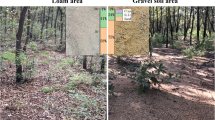Abstract
Conspecific trees growing at high and low-elevations encounter different growing conditions and may vary in their suitability as hosts for herbivorous insects. Mountain tree populations may be more resistant to herbivory if low temperatures constrain growth more than they constrain photosynthesis, resulting in increased secondary metabolism (temperature hypothesis). Alternatively, mountain trees may be fertilized by atmospheric nitrogen deposition and become more palatable to insects (atmospheric deposition hypothesis). We evaluated these two hypotheses by comparing high- and low-elevation trees with insect bioassays and analyses of foliar nitrogen and condensed tannin. Contrary to the temperature hypothesis, high-elevation foliage had higher leaf nitrogen (six of six tree species) and allowed higher growth rates of Lymantria dispar larvae (five of six tree species). The nitrogen deposition hypothesis was broadly supported by measurements from two mountains showing that high-elevation trees tended to have higher leaf nitrogen, lower leaf tannins, and support higher insect growth performance than conspecific trees from lower elevations. The deposition hypothesis was further supported by fertilization studies showing that simulated atmospheric nitrogen deposition changed the foliar chemistry of valley trees to resemble that of high-elevation trees. Predictions that the altitudinal gradient in foliar chemistry and host suitability should be steepest on mountains receiving more deposition were largely not supported, but interpretations are complicated by lack of replication among mountains. In the northeastern United States, increased host suitability of high-elevation trees seems sufficient to influence the population dynamics and community composition of herbivores. Atmospheric nitrogen deposition offers a promising hypothesis to explain and predict some important spatial patterns in herbivory.
Similar content being viewed by others
Author information
Authors and Affiliations
Additional information
Received: 21 September 1997 / Accepted: 12 June 1998
Rights and permissions
About this article
Cite this article
Erelli, M., Ayres, M. & Eaton, G. Altitudinal patterns in host suitability for forest insects. Oecologia 117, 133–142 (1998). https://doi.org/10.1007/s004420050641
Issue Date:
DOI: https://doi.org/10.1007/s004420050641




